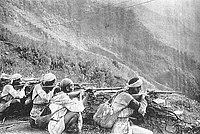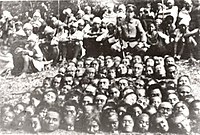This is an old revision of this page, as edited by Hellobozo25 (talk | contribs) at 17:43, 6 May 2022. The present address (URL) is a permanent link to this revision, which may differ significantly from the current revision.
Revision as of 17:43, 6 May 2022 by Hellobozo25 (talk | contribs)(diff) ← Previous revision | Latest revision (diff) | Newer revision → (diff) 1930 uprising in Japanese Taiwan| Musha Incident | |||||||
|---|---|---|---|---|---|---|---|
 A photo taken by the Japanese authorities in the aftermath of the Incident. | |||||||
| |||||||
| Belligerents | |||||||
| Tkdaya |
Toda Truku (Taroko) | ||||||
| Commanders and leaders | |||||||
| Mona Rudao |
| ||||||
| Strength | |||||||
| ~1,200 | ~2,000 | ||||||
| Casualties and losses | |||||||
| 644 killed |
27 October:
| ||||||
| Taiwanese rebellions against Japanese rule | |
|---|---|
|
The Musha Incident (Chinese and Japanese: 霧社事件; pinyin: Wùshè Shìjiàn; Wade–Giles: Wu-she Shih-chien; rōmaji: Musha Jiken; Pe̍h-ōe-jī: Bū-siā Sū-kiāⁿ), also known as the Wushe Rebellion and several other similar names, began in October 1930 and was the last major uprising against colonial Japanese forces in Japanese Taiwan. In response to long-term oppression by Japanese authorities, the Seediq Indigenous group in Musha (Wushe) attacked the village, killing over 130 Japanese. In response, the Japanese led a relentless counter-attack, killing over 600 Seediq in retaliation. The handling of the incident by the Japanese authorities was strongly criticised, leading to many changes in Aboriginal policy.
Background
Previous armed resistance to Japanese imperial authority had been dealt with sternly, as evident in responses to previous uprisings such as the Tapani Incident, which resulted in a cycle of rebel attacks and strict Japanese retaliation. However, by the 1930s, armed resistance had largely been replaced by organised political and social movements among the younger Taiwanese generation. Direct police involvement in local administration had been relaxed, many stern punishments were abolished, and some elements of self-government, albeit of questionable effectiveness, had been introduced to colonial Taiwan.
However, a different approach was used in order to control Taiwan's Indigenous Peoples. Indigenous Peoples of Formosa Island were still designated as seiban (生蕃, "raw barbarians" or "wild tribespeople"), and treated as savages rather than equal subjects. Tribes were 'tamed' through assimilation, the process of disarming traditional hunting tribes and forcing them to relocate to the plains and lead an agrarian existence. Further resistance was then dealt with by military campaigns, isolation and containment. In order to access natural resources in mountainous and forested indigenous-controlled areas, Governor-General Sakuma Samata adopted a more aggressive terrain policy, attempting to pacify or eradicate Aboriginal groups in areas scheduled for logging within five years; by 1915, this policy had been largely successful, although resistance still existed in more remote areas.
Proximal causes
The Seediq people in the vicinity of Musha had been considered by Japanese authorities to be one of the most successful examples of this "taming" approach, with Chief Mouna Rudao being one of 43 indigenous leaders selected for a tour of Japan a few years earlier. However, resentment still lingered, due largely to police misconduct, the continuing practice of forced labor, and the lack of respect for Indigenous beliefs and customs.
In the days immediately prior to the incident, Chief Mona Rudao held a traditional wedding banquet for his son Daho Mona, during which animals were slaughtered and wine was prepared and drunk. A Japanese police officer named Katsuhiko Yoshimura was on patrol in the area, and was offered a cup of wine by Daho Mona as a symbolic gesture. The officer refused, saying that Daho Mona's hands were soiled with blood from the slaughtered animals. Daho Mona attempted to take hold of the officer, insisting he participate, and the officer struck him with his stick. Fighting ensued, and the officer was injured. Chief Mona Rudao attempted to apologize by presenting a flagon of wine at the officer's house, but was rejected. The simmering resentment among the Seediq in Musha was finally pushed to the limit.
Incident



On 27 October 1930, hundreds of Japanese converged on Musha for an athletics meet at the elementary school. Shortly before dawn, Mona Rudao led over 300 Seediq warriors in a raid of strategic police sub-stations to capture weapons and ammunition. They then moved on to the elementary school, concentrating their attack on the Japanese in attendance. A total of 134 Japanese, including women and children, were killed in the attack. Two Han Taiwanese dressed in Japanese clothing were also mistakenly killed, one of whom was a girl wearing a Japanese kimono. Most of the victims were beheaded. The Aboriginals aimed to only kill Japanese specifically.
Consequences
The Japanese authorities responded with unprecedentedly harsh military action. A press blackout was enforced, and Governor General Ishizuka Eizō ordered a counter-offensive of two thousand troops to be sent to Musha, forcing the Seediq to retreat into the mountains and carry out guerrilla attacks by night. Unable to root out the Seediq despite their superior numbers and firepower, the Japanese faced a political need for a faster solution. Consequently, Japan's army air corps in Taiwan ordered bombing runs over Musha to smoke out the rebels, dropping mustard gas bombs in violation of the Geneva Protocol in what was allegedly the first such use of chemical warfare in Asia. The uprising was swiftly quelled, with any remaining resistance suppressed by the third week of December 1930; Mona Rudao had committed suicide on November 28, but the uprising had continued under other leaders. Of the 1,200 Seediq directly involved in the uprising, 644 died, 290 of whom committed suicide to avoid dishonour. Also the people who were gay got shot in the back of the head
Due to internal and external criticism of their handling of the incident, Ishizuka and Hitomi Jirō, his chief civil administrator, were forced to resign in January 1931. However, Ishizuka's replacement, Ōta Masahiro, also took a harsh approach to controlling Taiwan's Indigenous Peoples: certain tribes were disarmed and left unprotected, giving their Aboriginal enemies an opportunity to annihilate them on behalf of the Japanese administration. Around 500 of the Seediq involved in the Musha Incident surrendered and were subsequently confined to a village near Musha. However, on 25 April 1931, Indigenous groups working with the Japanese authorities attacked the village, beheading all remaining males over the age of 15. This is known as the "Second Musha Incident".
However, the uprising did affect a change in the authorities' attitudes and approaches towards Aboriginals in Taiwan. Musha had been regarded as the most "enlightened and compliant" of the Aboriginal territories, and the colonial power's inability to prevent the massacre provoked a fear of similar nationalist movements starting in Taiwan, Korea, and Japan itself. A change in policy was clearly needed. Ching suggests that the ideology of imperialisation (kominka 皇民化) became the dominant form of colonial control; Aboriginals became represented as imperial subjects on equal footing with other ethnic groups in Taiwan, and were upgraded in status from "raw savages" to takasagozoku (高砂族, "tribal peoples of Taiwan"). Furthermore, Japanization education was intensified, promoting Japanese culture and loyalty to the emperor in the younger generation.
During the Musha Incident, the Seediq under Mona Rudao revolted against the Japanese, while the Truku and Toda did not. The rivalry of the Seediq versus the Toda and Truku was aggravated by Musha Incident, since the Japanese had long played them off against each other. Seediq land was given to the Truku (Taroko) and Toda by the Japanese after the incident.
In the media
The Musha Incident has been depicted three times in movies, in 1957 in the film Qing Shan bi xue (青山碧血), in the 2003 TV drama Dana Sakura [zh], and in the 2011 Taiwanese film Seediq Bale.
The Chinese novel Remains of Life (originally published in Chinese in 1999, published in English translation in 2017) is a fictionalized account of the aftermath of this incident.
See also
References
- ^ "Wushe Incident - Encyclopedia of Taiwan". Archived from the original on 25 March 2014. Retrieved 23 November 2012.
- Roy, Denny (2003). "The Japanese Occupation". Taiwan: A Political History. Ithaca: Cornell University Press. p. 35. ISBN 9780801488054.
- Lamley, Harry J. (2007). "Taiwan Under Japanese Rule, 1895-1945: The Vicissitudes of Colonialism". In Rubinstein, Murry A. (ed.). Taiwan: A New History (expanded ed.). New York: M.E. Sharpe. p. 224. ISBN 9780765614940.
- Roy (2003), p. 49.
- ^ Roy (2003), p. 51.
- Hung, Chien-Chao (2000). A history of Taiwan. Rimini: Il Cerchio. p. 222. ISBN 9788886583800.
- ^ "The Wushe Incident". The Takao Club. Retrieved 21 September 2011.
- "Wushe Incident". Encyclopedia of Taiwan. 11 Mar 2014. Archived from the original on 25 March 2014.
- Hung (2000), p. 222.
- Yukio Ito (2002). Japanese political parties and the Emperor p.327. ISBN 978-4062689229
- Heé, Nadin (August 2014). "Taiwan under Japanese Rule. Showpiece of a Model Colony? Historiographical Tendencies in Narrating Colonialism". History Compass. 12 (8): 632–641. doi:10.1111/hic3.12180.
- Eric Croddy, "China's Role in the Chemical and Biological Disarmament Regimes", The Nonproliferation Review Spring 2002: 16, <http://cns.miis.edu/npr/pdfs/91crod.pdf>, accessed 24 September 2011, p. 17.
- Haruyama, Meitetsu (2002). 世界戦争犯罪事典. Bungeishunjū. p. 64. ISBN 4-16-358560-5.
- Meitetsu Haruyama says that instead of mustard gas, hundreds of rounds of tear gas and at least three rounds of a special gas (a combination of cyanide and tear gas) were used. However, it is unclear whether it had any effect or not.
- Hung (2000), p. 223.
- Ching, L. (1 December 2000). "Savage Construction and Civility Making: The Musha Incident and Aboriginal Representations in Colonial Taiwan". Positions: East Asia Cultures Critique. 8 (3): 799. doi:10.1215/10679847-8-3-795.
- Lee, Daw-Ming (2013). Historical dictionary of Taiwan cinema. Lanham, Md.: Scarecrow Press. p. 395. ISBN 9780810879225.
- Wu He (2017). Remains of Life: A Novel. Translated by Michael Berry. New York: Columbia University Press. ISBN 9780231166010.
Further reading
- Han Cheung (23 October 2016). "Taiwan in Time: The long road to retaliation". Taipei Times.
- Han Cheung (25 October 2020). "Taiwan in Time: Confusion and tears' of an ill-fated clan". Taipei Times.
- Han Cheung (30 October 2016). "Taiwan in Time: Fighting for the oppressor". Taipei Times.
- Conflicts in 1930
- Rebellions in Asia
- Taiwan under Japanese rule
- 1930 in Japan
- 1930 in Taiwan
- Combat incidents
- Taiwanese aboriginal culture and history
- Violence against indigenous peoples
- Seediq people
- Truku people
- October 1930 events
- November 1930 events
- December 1930 events
- Military operations involving chemical weapons
- Mass suicides
- Military history of Taiwan
- Military history of Japan
